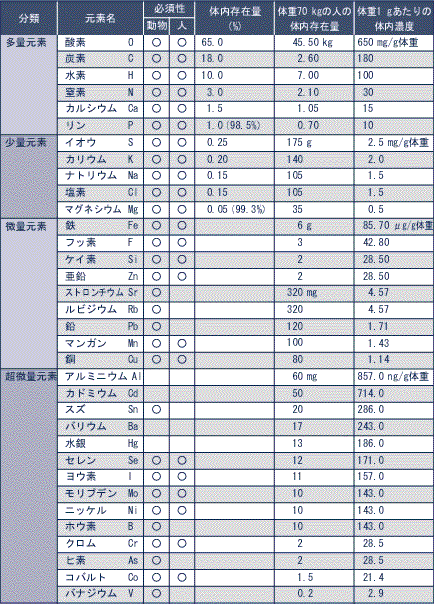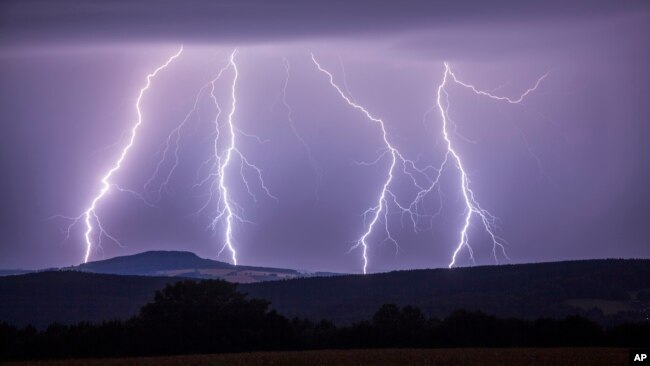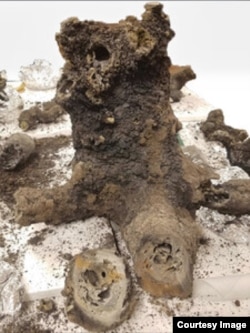生命誕生と雷の関係とは
驚きですね!!!
生命誕生に雷が重要な要素であったかも?といのは。
「生化学」「元素」満載の今回のVOAニュース!
いろんな分野を知ることができるVOAって良いですね♬
- 研究結果: 地球上の生命の発展に雷が役立った可能性
- 体の元素組成とその濃度https://www.aluminum.or.jp/aluminum-hc/p_6/sakurai/sakurai_main01.html
- Study: Lightning May Have Helped Life Develop on Earth
- Words in This Story
- 英語の小窓−number
- quintillion (百京) 1,000,000,000,000,000,000
- sextillion (十垓)
- Study: Lightning May Have Helped Life Develop on Earth
- quintillion (百京) 1,000,000,000,000,000,000
- sextillion (十垓)
研究結果: 地球上の生命の発展に雷が役立った可能性
Study: Lightning May Have Helped Life Develop on Earth
地球が形成された後に発生したlightning strikes落雷が、生命の誕生に必要な化学元素を解き放った可能性があるという新しい研究結果が発表されました。
研究者によると、地球が形成されてから最初の10億年の間に、雷が地球に十分なphosphorusリンを供給した可能性があるという。科学者たちは、地球上で生命が誕生したのは約35〜45億年前だと考えています。
※ phosphorus:[US] fɑ́sfərəs | [UK] fɔ́sfərəs リン
リンは、生命の形成に重要な元素です。リンは、細胞構造の形成や、ほぼすべてのliving organisms生物に存在するDNAを支える重要な元素です。しかし、初期の地球では、リンは水に溶けない鉱物の中に閉じ込められていたと考えられています。
※ living organisms:生物、生体
これまでは、”生物学的に利用可能な”リンの存在は、地球に衝突したmeteorites隕石が主な原因であると考えられてきました。隕石の中には、有機分子を形成する反応性の高いシュレイバーサイトと呼ばれるリンの鉱物が含まれているものがあります。
※ meteorites: 【míːtiəràit】隕石
※ organic molecules:有機分子
しかし、雷が地上に落ちると、地表の岩石が超高温になり、時には気化して、フルグライトと呼ばれるガラス状の岩石ができます。この過程で、内部に閉じ込められていたリンが解放されます。その結果、このフルグライトには、生命が誕生したと考えられている水に溶けるシュレイバーサイトが含まれていることがあります。
※ vaporize:【véipəràiz】 蒸発・気化する、蒸発・気化させる
※ soluble : [US] sɑ́ljəbəl | [UK] sɔ́ljubəl
(adj)溶けやすい、溶解(性)の、溶解できる、溶性の、水溶性の
アメリカとイギリスの研究者は、初期の地球では1年間に10億から50億回の落雷があったと推定しています−現在の年間落雷数は約5億6000万回。これは、10億年後には100京回の落雷があり、少なくとも10億個のフルグライトが形成されることになります。
※ quintillion – n. a number equal to 1 followed by 18 zeros/〈米〉10の18乗、100京
この研究成果をまとめた論文が、このほど英科学誌Nature Communicationsに掲載されました。
研究者によると、落雷によって生じたリンの鉱物は、約35億年前までに高くなっていたことが判明したといいます。これは、微生物のものであると広く認められている最古の化石の年代とほぼ同じであることがわかったといいます。
「落雷は、地球上の生命の誕生に重要な役割を果たした可能性があります。」とイェール大学大学院の地球惑星科学専攻に在籍するベンジャミン・ヘスさんはいいます。彼はこの研究の主執筆者です。
ヘスさんはロイター通信に対し、時間の経過とともに減少する隕石の衝突とは異なり、落雷は惑星の歴史の中で継続的に起こる可能性があると述べています。このことは、地球のような他の惑星で生命が誕生するために必要なリンを供給する上で、落雷も非常に重要な要素である可能性があることを意味している、と付け加えています。
研究者たちは、2016年にイリノイ州シカゴ郊外の家の近くに雷が落ちたときに形成された、異常に大きなフルグライトも調べました。「我々の研究は、落雷による生物学的に利用可能なリンの生成が過小評価されている可能性を示しています 。」と、研究の共同執筆者であるジェイソン・ハーベイ氏はロイターに語っています。同氏は英国のリーズ大学の地球化学の教授です。
生命に必要な物質としては、水、炭素、水素、窒素、酸素、硫黄、リン、そしてエネルギー源が考えられています。
※ carbon :炭素
hydrogen :水素
nitrogen :窒素
oxygen :酸素
sulfur :硫黄
科学者たちは、最古のバクテリアのような生物は、地球の初期水域で形成されたと考えています。しかし、それがいつ起こったのか、暖かくて浅い海で起こったのか、それとも深い海で起こったのかについては議論があります。
ヘスさんは、新しい研究によって、隕石が生命を育むリンの別の供給源であったかもしれないという説が完全に否定されたわけではないと述べています。
「生命が誕生した頃の隕石の衝突は、10年前に考えられていたよりもはるかに少ないのです。」とヘスさんは言います。「しかし、私たちの研究が、リンの供給源としての隕石に対抗するものだとは思っていません。源は多ければ多いほどいいのです。」と付け加えています。
体の元素組成とその濃度
https://www.aluminum.or.jp/aluminum-hc/p_6/sakurai/sakurai_main01.html
「人間の元素存在比」が紹介されており、酸素65.0%、炭素18.0%、水素10.0%、窒素3.0%、カルシウム1.5%、リン1.0%、少量元素0.9%、微量元素0.6%とまとめられています。

Study: Lightning May Have Helped Life Develop on Earth

A new study suggests lightning strikes that hit Earth after its formation may have unlocked a necessary chemical element to support the beginning of life.
Researchers say the lightning may have supplied enough phosphorus to Earth during the first billion years after the planet was formed. Scientists believe life started on Earth about 3.5 to 4.5 billion years ago.
Phosphorus is an important element for the formation of life. It helps form cell structures and supports DNA, the material present in nearly all living organisms. But on early Earth, phosphorus is believed to have been locked inside minerals that cannot dissolve in water.
Until now, it was widely believed that meteorites that struck Earth were mainly responsible for the presence of “bioavailable” phosphorus. Some meteorites contain a phosphorus mineral called schreibersite, a highly reactive mineral that can form organic molecules.

But when lightning strikes the ground, it can create glassy rocks called fulgurites by super-heating and sometimes vaporizing rocks on the surface. This process frees the phosphorus locked inside. As a result, these fulgurites can contain schreibersite, which is soluble in water, where life is thought to have formed.
Researchers in the United States and Britain estimated that early Earth saw 1 to 5 billion lightning strikes hit Earth each year - compared to about 560 million yearly today. That would add up to 1 quintillion strikes after a billion years, forming at least 1 billion fulgurites.
A study describing the research results recently appeared in the publication Nature Communications.
The researchers said phosphorus minerals caused by lightning strikes were found to have been higher by about 3.5 billion years ago. This is about the age of the earliest-known fossils widely accepted to be those of microorganisms, the researchers found.
“Lightning strikes, therefore, may have been a significant part of the emergence of life on Earth,” said Benjamin Hess, a Yale University graduate student in earth and planetary sciences. He was the lead writer of the study.
Hess told Reuters news agency that unlike meteorite hits that generally decrease over time, lightning strikes can happen continuously over a planet’s history. He added that this means lightning strikes may also be a very important element for providing the phosphorus needed for the emergence of life on other Earth-like planets.

The researchers also examined an unusually large fulgurite formed when lightning struck near a home outside Chicago, Illinois in 2016. “Our research shows that the production of bioavailable phosphorus by lightning strikes may have been underestimated,” study co-writer Jason Harvey told Reuters. He is a professor of geochemistry at Britain’s University of Leeds.
Among the materials considered necessary for life are water, carbon, hydrogen, nitrogen, oxygen, sulfur and phosphorus, along with an energy source.
Scientists believe the earliest bacteria-like organisms were formed in Earth’s early waters. But there is a debate over when this happened and whether it happened in warm and shallow waters or in deeper waters.
Hess said that new research does not completely cancel the theory that meteorites could have been another source of life-giving phosphorus.
"Meteor impacts around the time of the emergence of life are far less than thought a decade ago," Hess said. "But I don't see our work as a competition against meteorites as a source of phosphorus. The more sources, the better," he added.
Words in This Story
dissolve – v. to turn from a solid into a liquid
meteorite – n. a piece of rock or metal that has fallen to the ground from outer space: a meteor that reaches the surface of the Earth without burning up entirely
quintillion – n. a number equal to 1 followed by 18 zeros
fossil – v. part of an animal or plant from thousands of year ago, preserved in rock
emerge – v. to appear from somewhere
source – n. something that provides what is wanted or needed
shallow – adj. not deep
impact – n. an act or event in which something strikes another thing
decade – n. a period of 10 years
英語の小窓−number
1,000,000,000
さあ、何と読むでしょうか?
そうですよね! billion 10億。
ここで出てきた100京。10の18乗。0が18個ですね。
普段使いませんから。。。想像圏外です。
そこでその他も調てみました。
| 0の数 | 英語 | 日本語訳 |
|---|---|---|
| 0が12個 | trillion | 一兆 |
| 0が15個 |
quadrillion 【kwɑdríljən | kwɔdíljən】 |
千兆 |
| 0が18個 |
quintillion 【kwintíliən】 |
百京 |
| 0が21個 |
sextillion 【sekstíljən】 |
十垓 |
だそうです。
quintillion (百京) 1,000,000,000,000,000,000
sextillion (十垓)
地球が形成された後に発生したlightning strikes落雷が、生命の誕生に必要な化学元素を解き放った可能性があるという新しい研究結果が発表されました。
研究者によると、地球が形成されてから最初の10億年の間に、雷が地球に十分なphosphorusリンを供給した可能性があるという。科学者たちは、地球上で生命が誕生したのは約35〜45億年前だと考えています。
※phosphorus:[US] fɑ́sfərəs | [UK] fɔ́sfərəs リン
リンは、生命の形成に重要な元素です。リンは、細胞構造の形成や、ほぼすべてのliving organisms生物に存在するDNAを支える重要な元素です。しかし、初期の地球では、リンは水に溶けない鉱物の中に閉じ込められていたと考えられています。
※living organisms:生物、生体
これまでは、”生物学的に利用可能な”リンの存在は、地球に衝突したmeteorites隕石が主な原因であると考えられてきました。隕石の中には、有機分子を形成する反応性の高いシュレイバーサイトと呼ばれるリンの鉱物が含まれているものがあります。
meteorites: 【míːtiəràit】隕石
organic molecules:有機分子
しかし、雷が地上に落ちると、地表の岩石が超高温になり、時には気化して、フルグライトと呼ばれるガラス状の岩石ができます。この過程で、内部に閉じ込められていたリンが解放されます。その結果、このフルグライトには、生命が誕生したと考えられている水に溶けるシュレイバーサイトが含まれていることがあります。
vaporize:【véipəràiz】 蒸発・気化する、蒸発・気化させる
soluble : [US] sɑ́ljəbəl | [UK] sɔ́ljubəl
(adj)溶けやすい、溶解(性)の、溶解できる、溶性の、水溶性の
アメリカとイギリスの研究者は、初期の地球では1年間に10億から50億回の落雷があったと推定しています−現在の年間落雷数は約5億6000万回。これは、10億年後には100京回の落雷があり、少なくとも10億個のフルグライトが形成されることになります。
quintillion – n. a number equal to 1 followed by 18 zeros/〈米〉10の18乗、100京
この研究成果をまとめた論文が、このほど英科学誌「Nature Communications」に掲載された。
研究者によると、落雷によって生じたリンの鉱物は、約35億年前までに高くなっていたことが判明したという。これは、微生物のものであると広く認められている最古の化石の年代とほぼ同じであることがわかったという。
"イェール大学大学院の地球惑星科学専攻に在籍するベンジャミン・ヘスは、「落雷は、地球上の生命の誕生に重要な役割を果たした可能性があります。彼はこの研究の主執筆者である。
ヘスはロイター通信に対し、時間の経過とともに減少する隕石の衝突とは異なり、落雷は惑星の歴史の中で継続的に起こる可能性があると述べています。このことは、地球のような他の惑星で生命が誕生するために必要なリンを供給する上で、落雷も非常に重要な要素である可能性があることを意味しています」と付け加えた。
シカゴ大学でラマン分光法を用いて分析中のフルグライトのカットサンプル。(エール大学)
シカゴ大学でラマン分光法を用いて分析中のフルグライトのカットサンプル。(イェール大学)
研究者たちは、2016年にイリノイ州シカゴ郊外の家の近くに雷が落ちたときに形成された、異常に大きなフルグライトも調べました。"我々の研究は、落雷による生物学的に利用可能なリンの生成が過小評価されている可能性を示している "と、研究の共同執筆者であるジェイソン・ハーベイ氏はロイターに語った。同氏は英国のリーズ大学の地球化学の教授である。
生命に必要な物質としては、水、炭素、水素、窒素、酸素、硫黄、リン、そしてエネルギー源が考えられています。
科学者たちは、最古のバクテリアのような生物は、地球の初期水域で形成されたと考えています。しかし、それがいつ起こったのか、暖かくて浅い海で起こったのか、それとも深い海で起こったのかについては議論がある。
ヘスは、新しい研究によって、隕石が生命を育むリンの別の供給源であったかもしれないという説が完全に否定されたわけではないと述べている。
"生命が誕生した頃の隕石の衝突は、10年前に考えられていたよりもはるかに少ない」とヘスは言う。"しかし、私たちの研究が、リンの供給源としての隕石に対抗するものだとは思っていません。ソースは多ければ多いほどいいのです」と付け加えた。
Study: Lightning May Have Helped Life Develop on Earth

A new study suggests lightning strikes that hit Earth after its formation may have unlocked a necessary chemical element to support the beginning of life.
Researchers say the lightning may have supplied enough phosphorus to Earth during the first billion years after the planet was formed. Scientists believe life started on Earth about 3.5 to 4.5 billion years ago.
Phosphorus is an important element for the formation of life. It helps form cell structures and supports DNA, the material present in nearly all living organisms. But on early Earth, phosphorus is believed to have been locked inside minerals that cannot dissolve in water.
Until now, it was widely believed that meteorites that struck Earth were mainly responsible for the presence of “bioavailable” phosphorus. Some meteorites contain a phosphorus mineral called schreibersite, a highly reactive mineral that can form organic molecules.

But when lightning strikes the ground, it can create glassy rocks called fulgurites by super-heating and sometimes vaporizing rocks on the surface. This process frees the phosphorus locked inside. As a result, these fulgurites can contain schreibersite, which is soluble in water, where life is thought to have formed.
Researchers in the United States and Britain estimated that early Earth saw 1 to 5 billion lightning strikes hit Earth each year - compared to about 560 million yearly today. That would add up to 1 quintillion strikes after a billion years, forming at least 1 billion fulgurites.
A study describing the research results recently appeared in the publication Nature Communications.
The researchers said phosphorus minerals caused by lightning strikes were found to have been higher by about 3.5 billion years ago. This is about the age of the earliest-known fossils widely accepted to be those of microorganisms, the researchers found.
“Lightning strikes, therefore, may have been a significant part of the emergence of life on Earth,” said Benjamin Hess, a Yale University graduate student in earth and planetary sciences. He was the lead writer of the study.
Hess told Reuters news agency that unlike meteorite hits that generally decrease over time, lightning strikes can happen continuously over a planet’s history. He added that this means lightning strikes may also be a very important element for providing the phosphorus needed for the emergence of life on other Earth-like planets.

The researchers also examined an unusually large fulgurite formed when lightning struck near a home outside Chicago, Illinois in 2016. “Our research shows that the production of bioavailable phosphorus by lightning strikes may have been underestimated,” study co-writer Jason Harvey told Reuters. He is a professor of geochemistry at Britain’s University of Leeds.
Among the materials considered necessary for life are water, carbon, hydrogen, nitrogen, oxygen, sulfur and phosphorus, along with an energy source.
Scientists believe the earliest bacteria-like organisms were formed in Earth’s early waters. But there is a debate over when this happened and whether it happened in warm and shallow waters or in deeper waters.
Hess said that new research does not completely cancel the theory that meteorites could have been another source of life-giving phosphorus.
"Meteor impacts around the time of the emergence of life are far less than thought a decade ago," Hess said. "But I don't see our work as a competition against meteorites as a source of phosphorus. The more sources, the better," he added.
Words in This Story
dissolve – v. to turn from a solid into a liquid
meteorite – n. a piece of rock or metal that has fallen to the ground from outer space: a meteor that reaches the surface of the Earth without burning up entirely
quintillion – n. a number equal to 1 followed by 18 zeros
fossil – v. part of an animal or plant from thousands of year ago, preserved in rock
emerge – v. to appear from somewhere
source – n. something that provides what is wanted or needed
shallow – adj. not deep
impact – n. an act or event in which something strikes another thing
decade – n. a period of 10 years
英語の小窓−number
1,000,000,000
さあ、何と読むでしょうか?
そうですよね! billion 10億。
ここで出てきた100京。普段使いませんから。。。
そこで
quadrillion:【kwɑdríljən | kwɔdíljən 】 100兆 10の15乗
quintillion :100京
sextillion :10
| 0の数 | 英語 | 日本語訳 | |||||||||||||||
|---|---|---|---|---|---|---|---|---|---|---|---|---|---|---|---|---|---|
| 0が12個 | trillion | 一兆 | |||||||||||||||
| 0が15個 | quadrillion(
|
千兆 | |||||||||||||||
| 0が18個 | quintillion(クインティリオン) | 百京 | |||||||||||||||
| 0が21個 | sextillion(セクスティリオン) | 十垓 |
だそうです。
quintillion (百京) 1,000,000,000,000,000,000
sextillion (十垓)